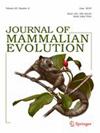Deinotherium levius and Tetralophodon longirostris (Proboscidea, Mammalia) from the Late Miocene hominid locality Hammerschmiede (Bavaria, Germany), and their biostratigraphic significance for the terrestrial faunas of the European Miocene
IF 2.1
3区 生物学
Q2 ZOOLOGY
引用次数: 0
Abstract
Abstract During the Miocene, proboscideans reached their greatest diversification, and due to their marked evolutionary changes in dental size and morphology, they comprise an important biostratigraphic/biochronological tool. In this article, we study the proboscideans from the Late Miocene hominid locality Hammerschmiede (Germany), whose fossiliferous layers HAM 6, HAM 4 and HAM 5 are dated to 11.42, 11.44 and 11.62 Ma, respectively. The studied material consists of mandibular, tusk and cheek tooth specimens, which are attributed to the deinothere Deinotherium levius and the tetralophodont gomphothere Tetralophodon longirostris . An almost complete juvenile mandible of D. levius was CT-scanned and revealed that the erupting lower tusks represent the permanent ones. The mandible is most possibly associated with a lower deciduous tusk, and therefore these specimens capture the rare, and short in duration, moment of transition between deciduous and permanent lower tusks in fossil proboscideans and represent the first such example in deinotheres. The chronologically well-constrained proboscidean fauna from Hammerschmiede and the examination of other assemblages from European localities indicate that the coexistence of D. levius and T. longirostris characterizes the late Astaracian–earliest Vallesian, while Hammerschmiede may showcase the transition from the Middle Miocene trilophodont ( Gomphotherium )-dominated faunas of central Europe to the Late Miocene tetralophodont-dominated ones. Finally, in order to decipher the dietary preferences of the Hammerschmiede Tetralophodon we performed dental mesowear angle analysis, which revealed a mixed-feeding diet with an important browsing component, significantly different from the heavily browsing one of Deinotherium known from other localities. Such distinct feeding habits between the taxa indicate niche partitioning, which allowed their sympatry.

德国巴伐利亚Hammerschmiede晚中新世原始人地区的levius Deinotherium和Tetralophodon longirostris (probosciia,哺乳纲)及其对欧洲中新世陆生动物的生物地层意义
在中新世,长鼻猿达到了最大的多样化,由于它们在牙齿大小和形态上的显著进化变化,它们构成了一个重要的生物地层/生物年代学工具。本文研究了德国Hammerschmiede晚中新世古人类地区的长吻目动物,其化石层ham6、ham4和ham5的年代分别为11.42、11.44和11.62 Ma。所研究的材料包括下颌、象牙和颊齿标本,分别属于deinothere Deinotherium levius和Tetralophodon gomphothere Tetralophodon longirostris。对一具几乎完整的幼年龙下颌骨进行了ct扫描,发现喷发出来的下牙代表了永久的牙齿。下颌骨很可能与较低的乳牙有关,因此这些标本捕捉到了化石长鼻目动物中罕见的、持续时间短的、从乳牙到永久的较低象牙之间的过渡时刻,并代表了兽目动物中第一个这样的例子。来自Hammerschmiede的长鼻目动物群的年代学约束良好,以及对欧洲地区其他组合的研究表明,D. levius和T. longirostris共存是阿斯塔拉纪晚期-瓦利西亚早期的特征,而Hammerschmiede可能显示了中欧从中新世中期以三足兽(Gomphotherium)为主的动物群向晚中新世以四足兽为主的动物群的过渡。最后,为了解释Hammerschmiede tetralophoton的饮食偏好,我们进行了牙齿中磨损角分析,发现Hammerschmiede tetralophoton的饮食偏好与其他地区的Deinotherium的饮食偏好明显不同,混合饮食中有重要的浏览成分。这两个分类群之间如此不同的摄食习性表明了生态位的划分,这使得它们能够同属。
本文章由计算机程序翻译,如有差异,请以英文原文为准。
求助全文
约1分钟内获得全文
求助全文
来源期刊

Journal of Mammalian Evolution
ZOOLOGY-
CiteScore
4.30
自引率
10.50%
发文量
45
审稿时长
>12 weeks
期刊介绍:
Journal of Mammalian Evolution is a multidisciplinary forum devoted to studies on the comparative morphology, molecular biology, paleobiology, genetics, developmental and reproductive biology, biogeography, systematics, ethology and ecology, and population dynamics of mammals and the ways that these diverse data can be analyzed for the reconstruction of mammalian evolution. The journal publishes high-quality peer-reviewed original articles and reviews derived from both laboratory and field studies. The journal serves as an international forum to facilitate communication among researchers in the multiple fields that contribute to our understanding of mammalian evolutionary biology.
 求助内容:
求助内容: 应助结果提醒方式:
应助结果提醒方式:


